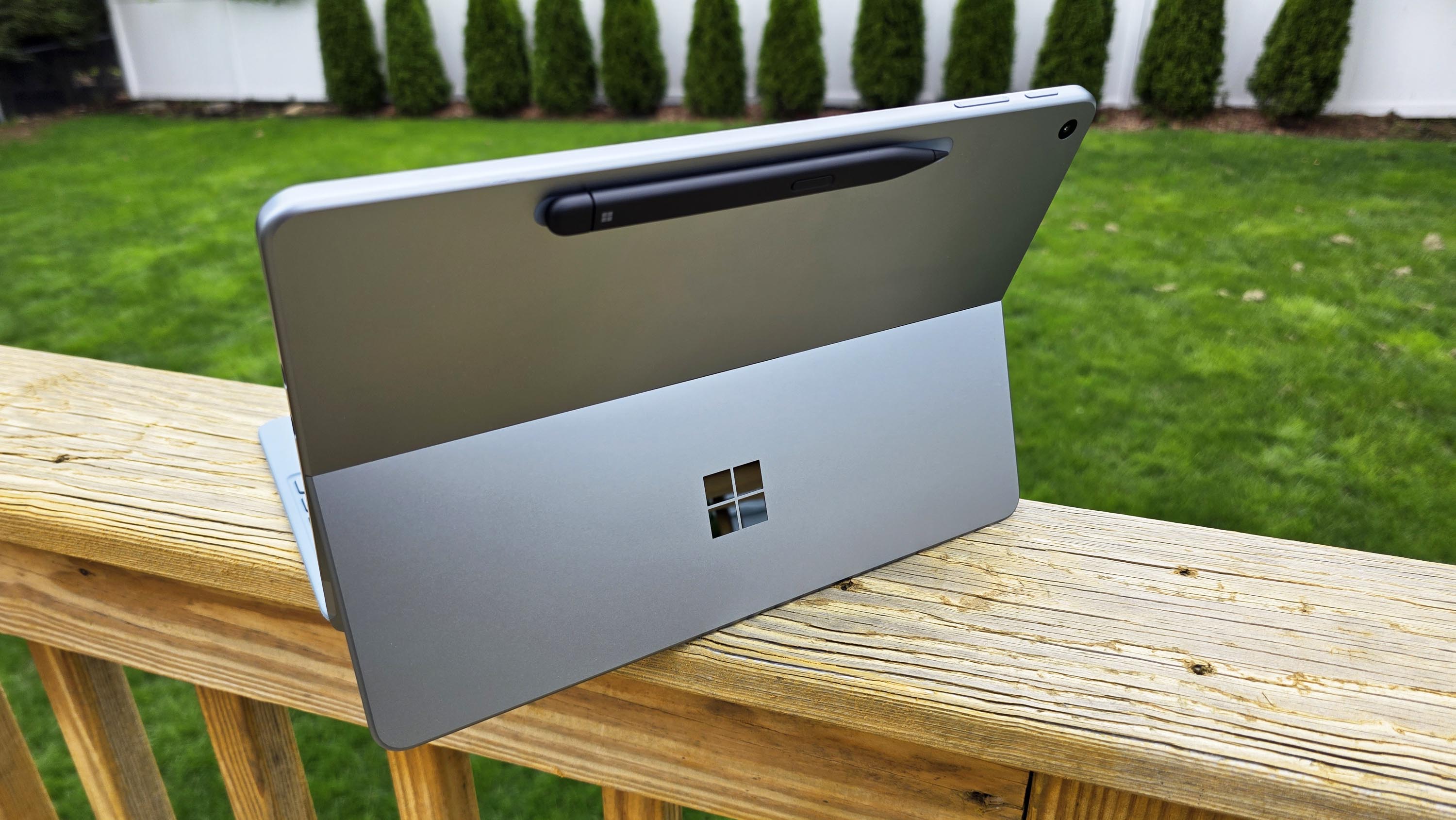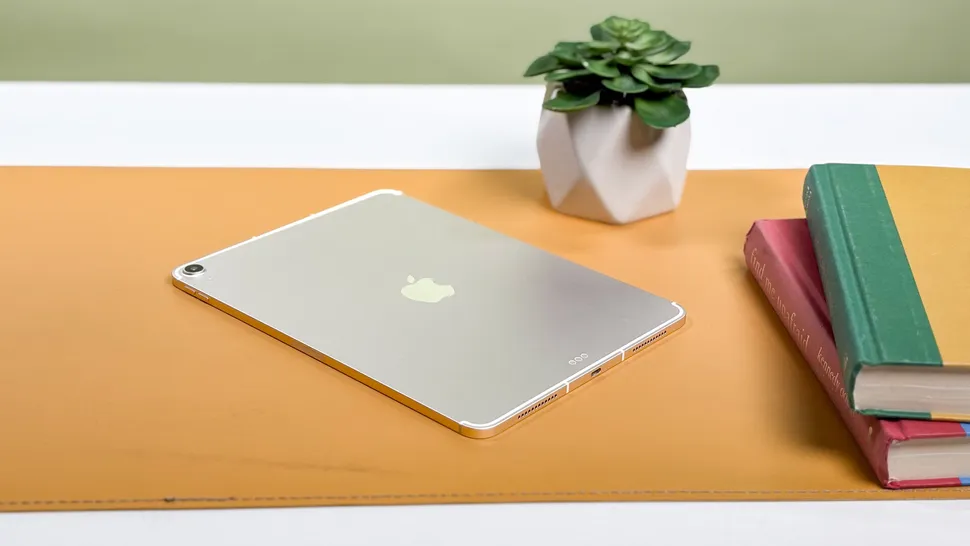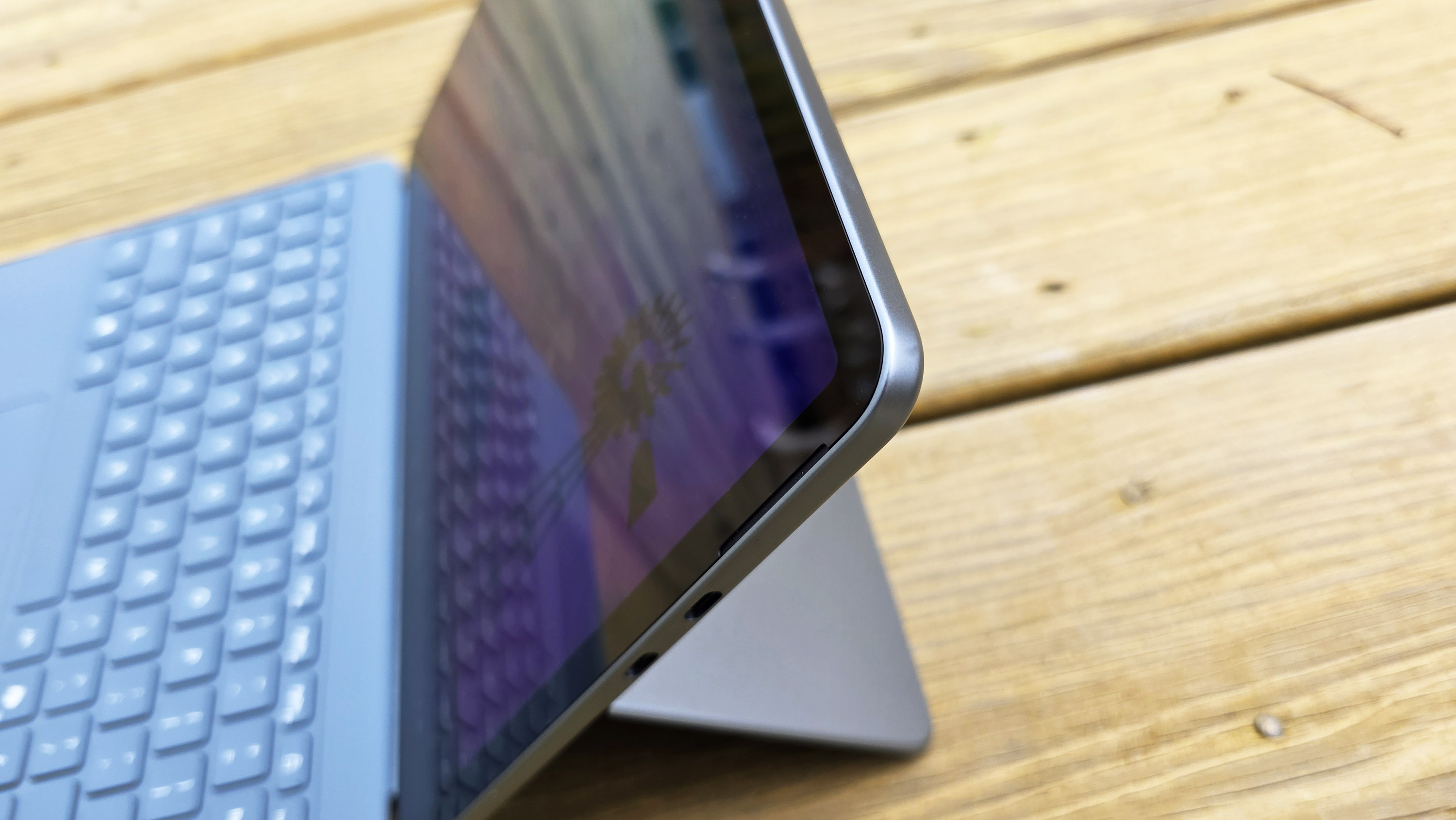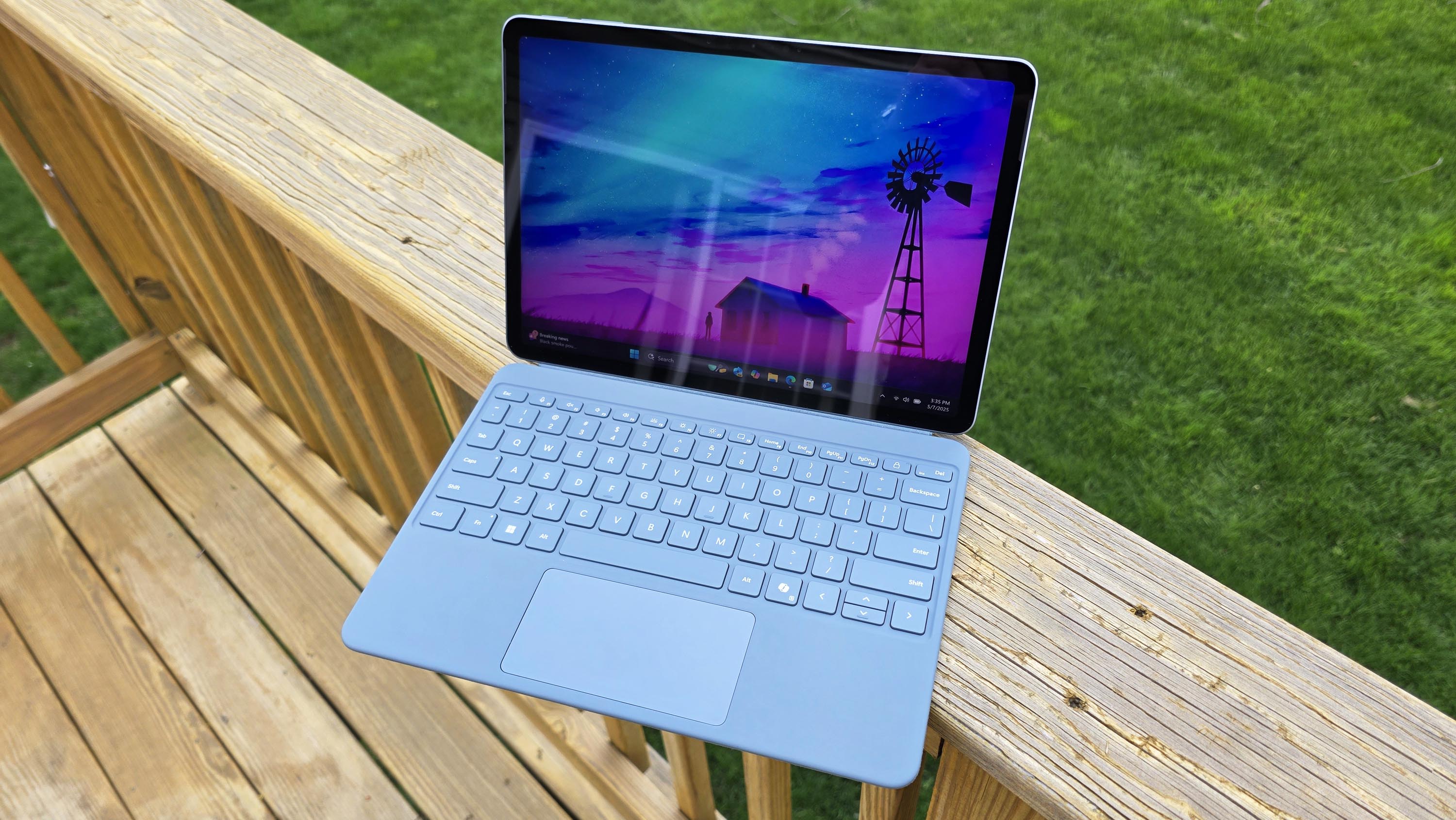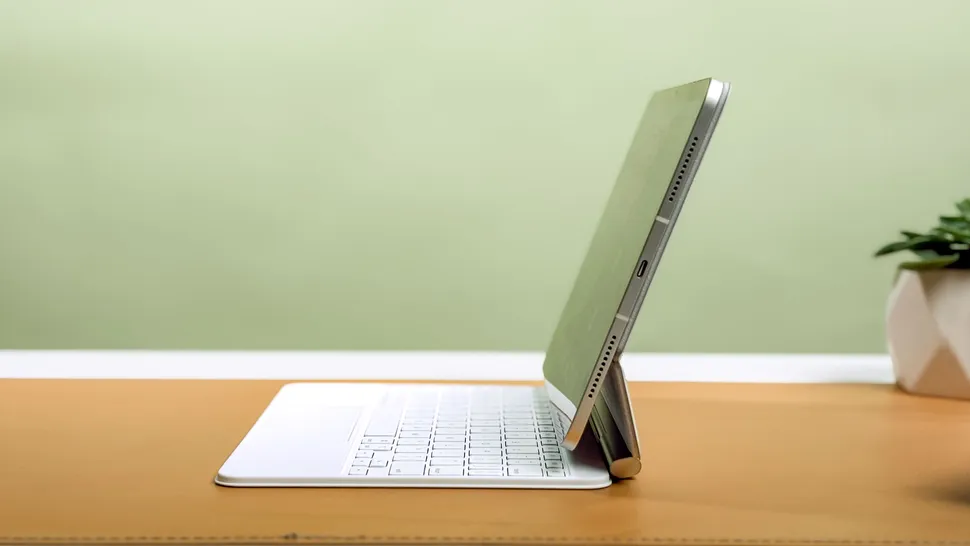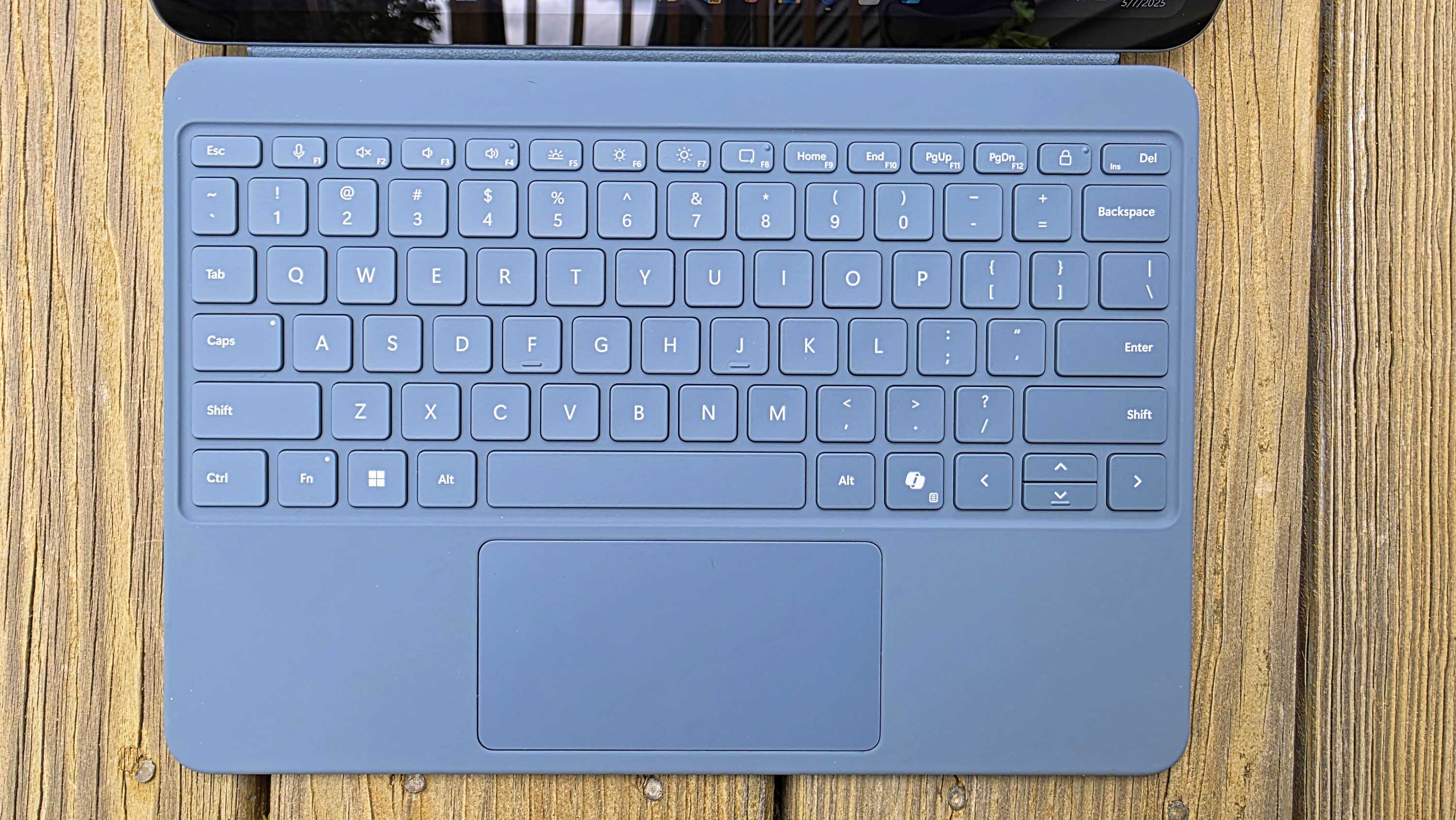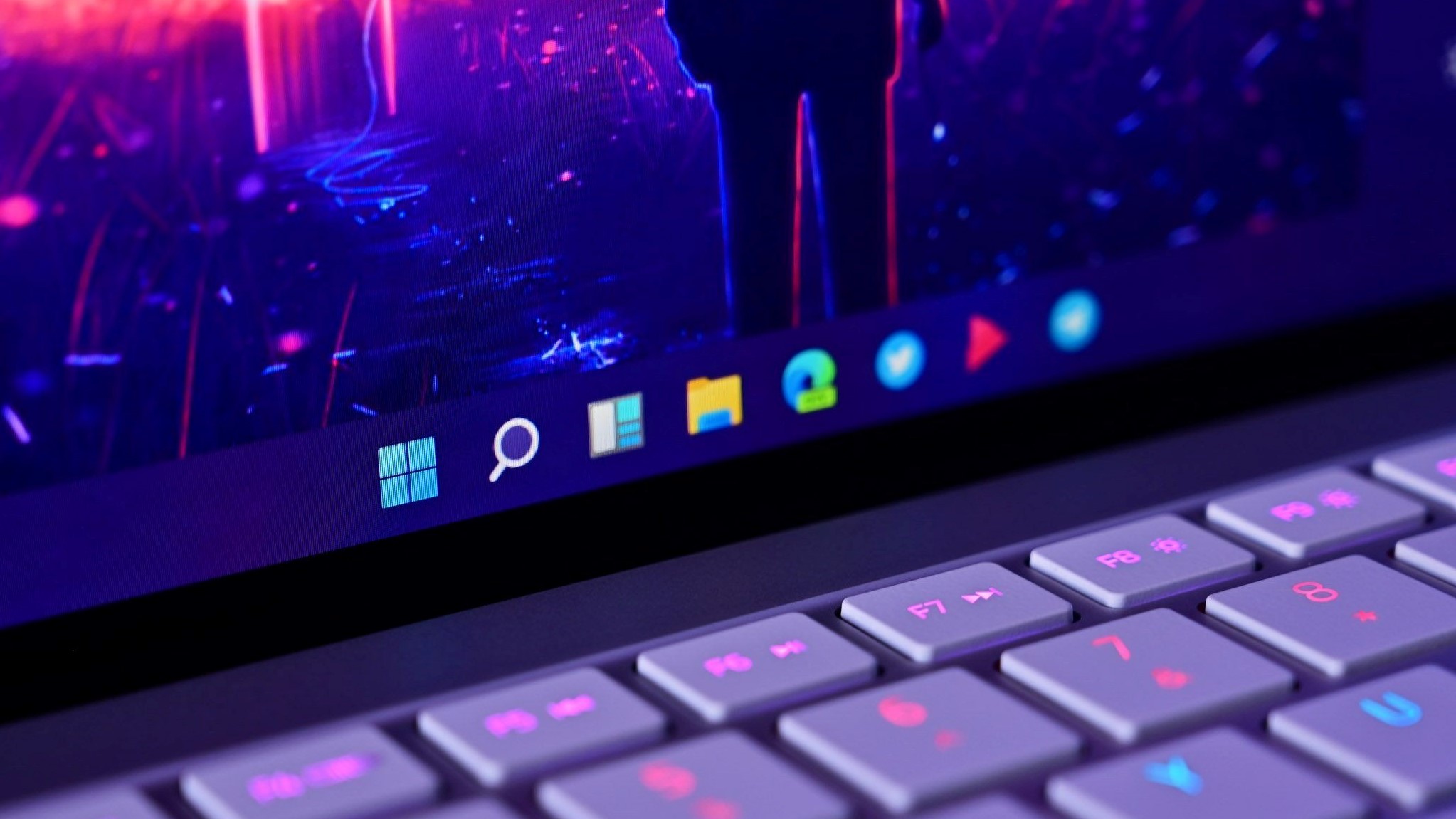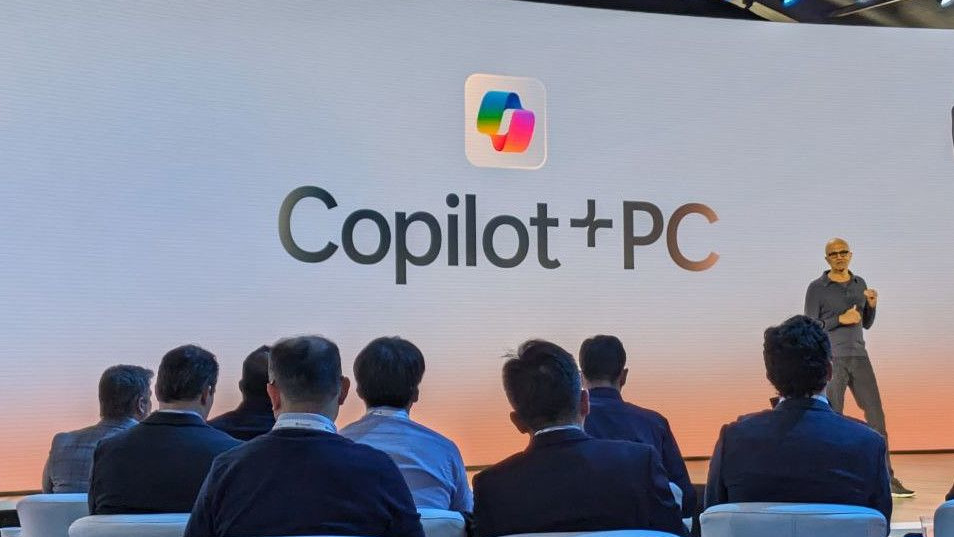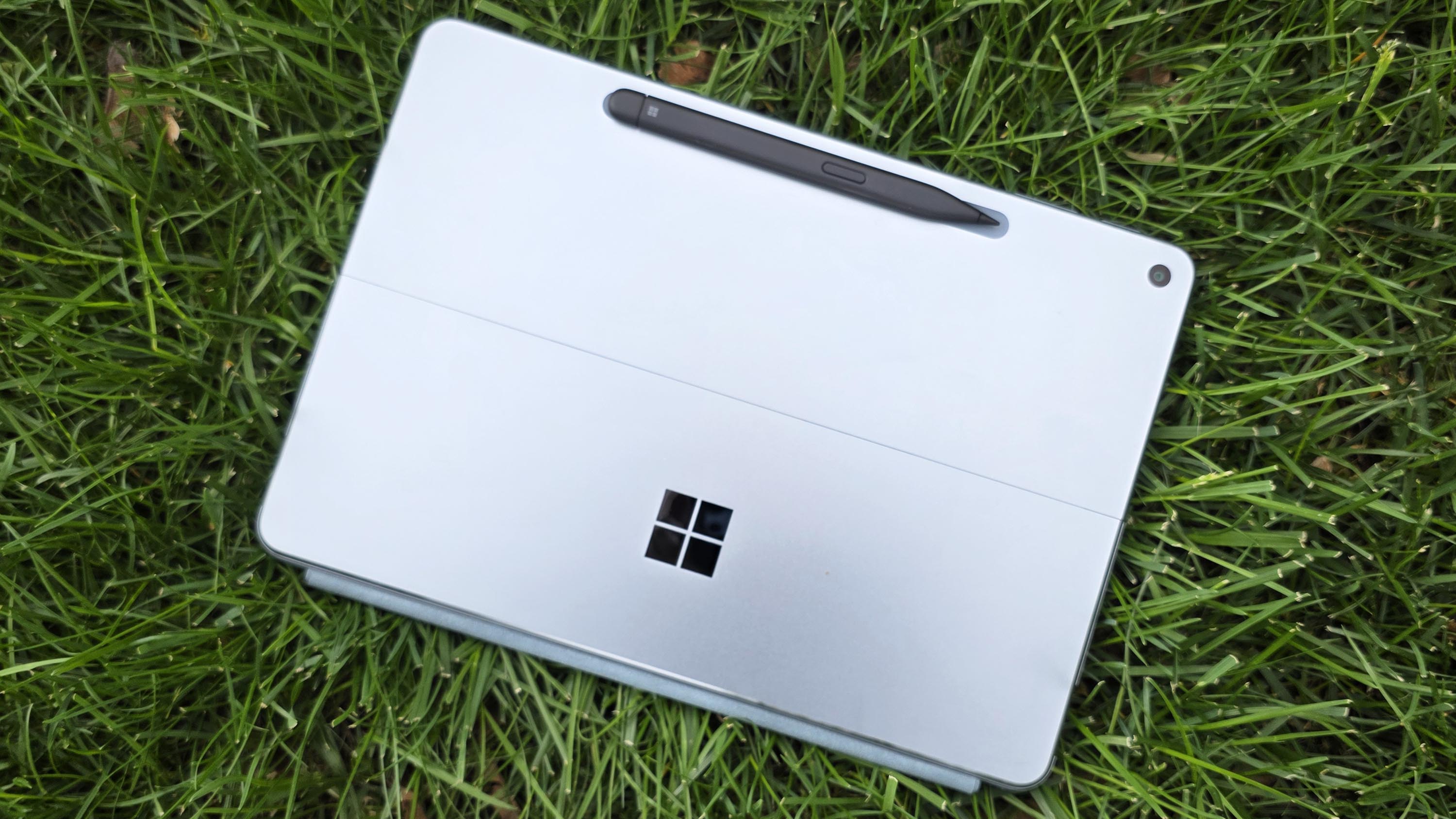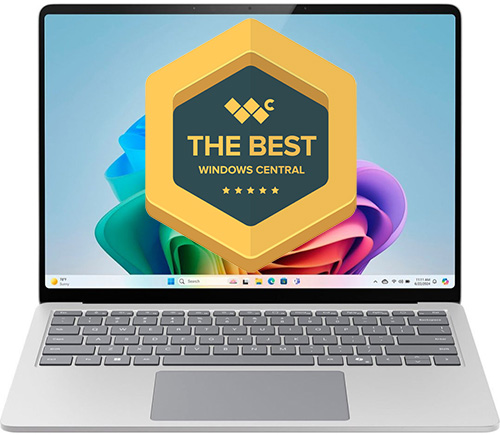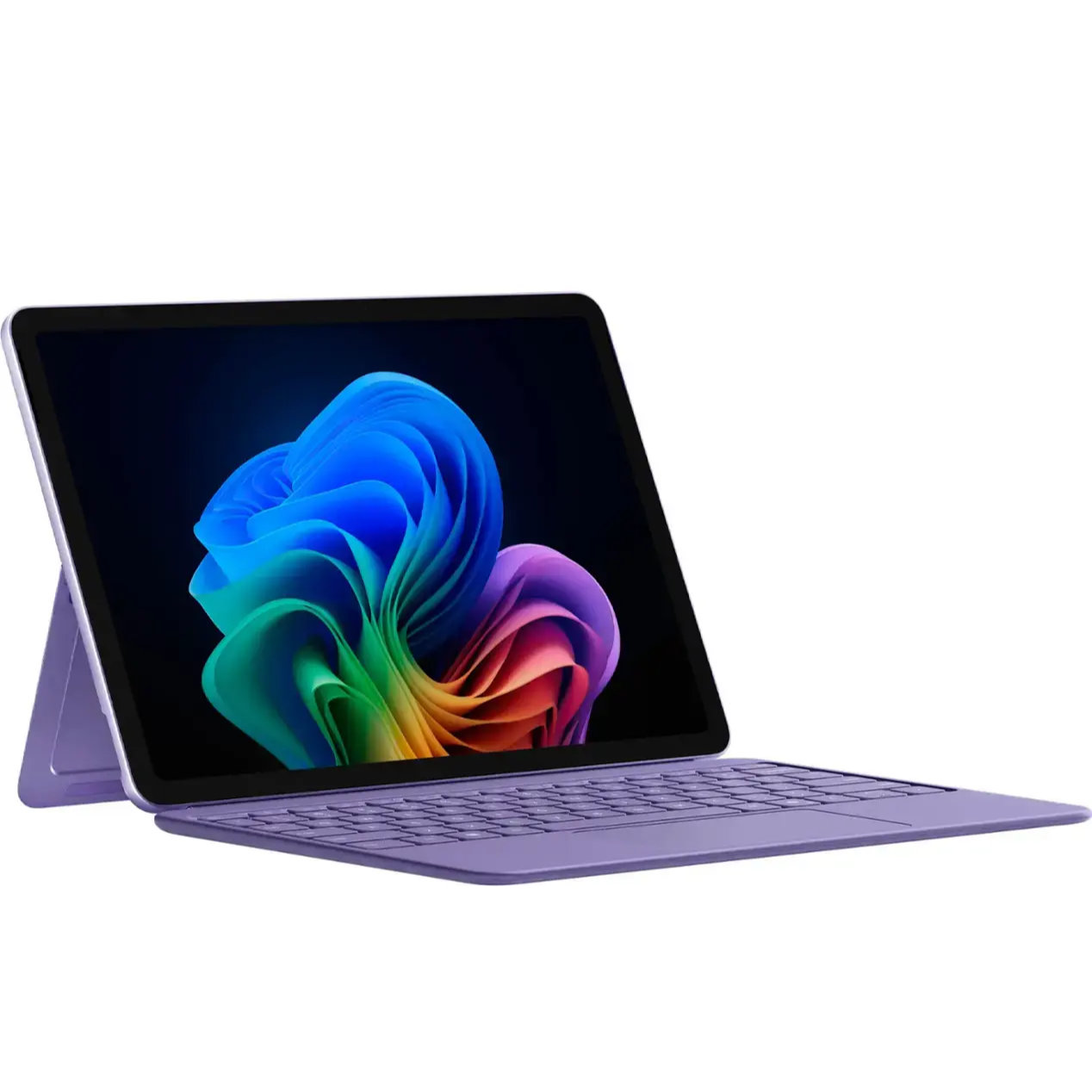
The Surface Pro 12-inch delivers a superior notebook experience thanks to its built-in stand, sleek keyboard, and full Windows 11 on Snapdragon. You get a lot more computer (more RAM, more storage, better functionality) for your money here, although it does cost more to start.
Pros
- More affordable keyboard includes a backlight
- Snapdragon X Plus with 45 TOPS NPU gets full access to Copilot+
- 16GB of RAM is standard
- Dual external display support
Cons
- UFS storage not as quick as a true SSD
- More expensive to start
- Lower display pixel density
- SSD upgrade requires opening the case
- Cameras aren't as impressive
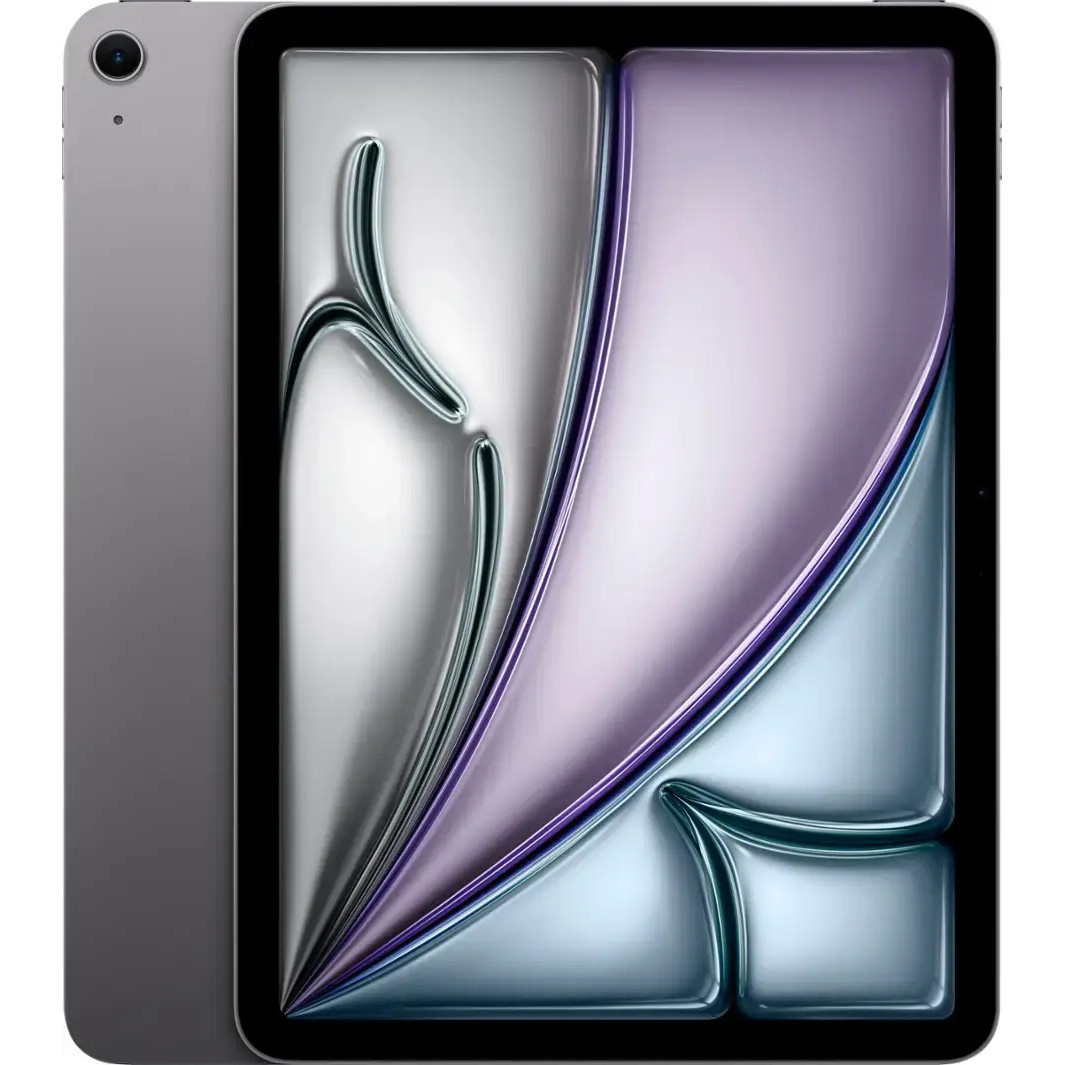
The iPad Air M3 delivers a superior tablet experience in 11- and 13-inch sizes, and it starts at a cheaper price. However, it quickly becomes the pricier option, especially when accessories like a keyboard and pen are added. Pick it up if you prefer the iPadOS experience or require 5G connectivity.
Pros
- Optional 5G connectivity
- Two sizes available (11" and 13")
- Starts at a cheaper price
- More color options available
- The superior "tablet" experience
Cons
- Only 8GB of RAM
- Keyboard costs more, no backlight
- No built-in stand
- SSD is permanent
- Fewer ports, only supports one external display
Microsoft just unveiled a new, smaller Surface Pro 12-inch with Snapdragon inside, and it leans more into the modern slab tablet design that Apple shares.
Apple also recently updated its iPad Air lineup with a new M3 series, available in 11-inch and 13-inch sizes.
👉 Related: Surface Pro 12-inch — First impressions and hands-on review
Considering how close these devices are in price and design, you might be wondering which one is better suited to your needs.
I can help with this detailed comparison between the Surface Pro 12-inch and the iPad Air M3.
Surface Pro 12-inch vs. iPad Air M3: Specifications
I've laid out the raw specifications that make up the new Surface Pro 12-inch and the iPad Air M3 before I get into a detailed comparison.
| Header Cell - Column 0 | Surface Pro 12-inch | iPad Air M3 11" | iPad Air M3 13" |
|---|---|---|---|
SoC | Qualcomm Snapdragon X Plus X1P-42-100 (8-core) | Apple M3 (8-core) | Apple M3 (8-core) |
RAM | 16GB LPDDR5x | 8GB | 8GB |
GPU | Qualcomm Adreno (integrated) | Apple (9-core) | Apple (9-core) |
NPU | Qualcomm Hexagon (45 TOPS) | 18 TOPS | 18 TOPS |
Storage | 256GB, 512GB UFS | 128GB, 256GB, 512GB, 1TB SSD (soldered) | 128GB, 256GB, 512GB, 1TB SSD (soldered) |
Camera | Front-facing 1080p + IR, rear-facing 10MP | Front-facing 12MP, rear-facing 12MP | Front-facing 12MP, rear-facing 12MP |
Speakers | Dual 2W speakers, Dolby Atmos | Stereo speakers | Stereo speakers |
Display | 12 inches, 2196x1464 (2.1K), 220 PPI, LCD, 3:2 aspect ratio, 90Hz, touch, 400 nits | 11 inches, IPS, 2360x1640, 264 PPI, 60Hz, 500 nits | 13 inches, IPS, 2732x2048, 264 PPI, 60Hz, 600 nits |
Ports | Two USB-C 3.2 (10Gbps) | One USB-C (10Gbps) | One USB-C (10Gbps) |
Wireless | Wi-Fi 7, Bluetooth 5.4 | Wi-Fi 6E, Bluetooth 5.3, 5G LTE (optional) | Wi-Fi 6E, Bluetooth 5.3, 5G LTE (optional) |
Battery | Up to 16 hours video playback | 29Wh, up to 10 hours active web usage | 36.5Wh, up to 10 hours active web usage |
Dimensions | 10.8 x 7.47 x 0.30 inches (274mm x 190mm x 7.8mm) | 9.74 x 7.02 x 0.24 inches (247.6mm x 178.5mm x 6.1mm) | 11.04 x 8.46 x 0.24 inches (280.6mm x 214.9mm x 6.1mm) |
Weight | 1.5 pounds (686g) | 1.01 pounds (460g) | 1.36 pounds (616g) |
Colors | Platinum, Ocean, Violet | Blue, Purple, Starlight, Space Gray | Blue, Purple, Starlight, Space Gray |
OS | Windows on Snapdragon | iPadOS 18 | iPadOS 18 |
Price | From $799 | From $599 | From $799 |
Surface Pro 12-inch vs. iPad Air M3: Price and availability
The Surface Pro 12-inch was revealed on May 6, and preorders are now live with shipping expected on May 20, 2025.
All the latest news, reviews, and guides for Windows and Xbox diehards.
Prices start at $799.99 for a model with an 8-core Snapdragon X Plus chip, 16GB of RAM, and 256GB of storage. It's available in a Platinum finish.
There's also an $899 model with the same Snapdragon System-on-Chip (SoC), 16GB of RAM, and 512GB of storage. It's available in Platinum, Violet, and Ocean colors.
Here's a breakdown of pricing, including the Slim Pen 2 and new Surface Pro 12 Keyboard; Best Buy has everything in stock and ready to go.
- Surface Pro 12-inch, Platinum, 16GB RAM, 256GB SSD: $799.99 at Best Buy
- Surface Pro 12-inch, Platinum, 16GB RAM, 512GB SSD: $899.99 at Best Buy
- Surface Pro 12-inch, Violet, 16GB RAM, 512GB SSD: $899.99 at Best Buy
- Surface Pro 12-inch, Ocean, 16GB RAM, 512GB SSD: $899.99 at Best Buy
- Surface Slim Pen 2: $129.99 at Best Buy
- Surface Pro 12 Keyboard: $149.99 at Best Buy
- Surface Pro 12 Keyboard with Slim Pen: $249.99 at Best Buy
The 11-inch iPad Air M3 starts at a more affordable $599, but it has half as much RAM and storage as the introductory Surface Pro 12-inch model.
Unfortunately, 8GB is the maximum amount of memory in all models, and there's no way to upgrade after purchase. The same goes for the soldered storage.
For an 11-inch iPad Air M3 with 256GB SSD and 8GB of RAM, you're looking at about $699, or $100 less than the new Surface Pro.
The 13-inch iPad Air M3 models start at $799 and have 8GB of RAM and a 128GB SSD. Prices quickly climb from there.
Apple offers more colors and configuration options for its iPad Air M3, mostly due to there being both 11- and 13-inch sizes.
Also noteworthy is the ability to add 5G connectivity to the usual Wi-Fi, something that the Surface Pro 12-inch lacks.
Here's a breakdown of the prices you can expect to pay for the iPad Air M3.
- Apple iPad Air M3, 11", 8GB RAM, 128GB SSD: $599 at Best Buy
- Apple iPad Air M3, 11", 8GB RAM, 256GB SSD: $699 at Best Buy
- Apple iPad Air M3, 13", 8GB RAM, 128GB SSD: $799 at Best Buy
- Apple iPad Air M3, 11", 8GB RAM, 256GB SSD, 5G: $849 at Best Buy
- Apple iPad Air M3, 11", 8GB RAM, 512GB SSD: $899 at Best Buy
- Apple iPad Air M3, 13", 8GB RAM, 256GB SSD: $899 at Best Buy
- Apple iPad Air M3, 13", 8GB RAM, 256GB SSD, 5G: $1,049 at Best Buy
- Apple iPad Air M3, 11", 8GB RAM, 1TB SSD: $1,099 at Best Buy
- Apple iPad Air M3, 13", 8GB RAM, 512GB SSD: $1,099 at Best Buy
- Apple iPad Air M3, 13", 8GB RAM, 512GB SSD, 5G: $1,249 at Best Buy
- Apple iPad Air M3, 13", 8GB RAM, 1TB SSD, 5G: $1,449 at Best Buy
- Apple Pencil Pro: $129 at Best Buy
- Apple Magic Keyboard (11"): $269 at Best Buy
- Apple Magic Keyboard (13"): $319 at Best Buy
Apple's Magic Keyboard is more expensive than the Surface Pro 12-inch Keyboard, though the Apple Pencil Pro is about the same cost as the Surface Slim Pen 2.
Overall, you can spend less on the iPad Air M3's basic configurations, but you'll have to make peace with 8GB of RAM and 128GB of storage.
Apple's pricing quickly catches up to and far surpasses that of the Surface Pro 12-inch.
The table below shows how Apple's pricing compares even before adding more than 128GB or 256GB of storage (and with half as much RAM).
Spec | Surface Pro 12-inch | iPad Air M3 11" | iPad Air M3 13" |
|---|---|---|---|
Device alone | $799.99 (16GB / 256GB) | $599 (8GB / 128GB) | $799 (8GB / 128GB) |
Device alone | $799.99 (16GB / 256GB) | $699 (8GB / 256GB) | $899 (8GB / 256GB) |
Device + Keyboard | $949.98 (16GB / 256GB) | $868 (8GB / 128GB) | $1,118 (8GB / 128GB) |
Device + Keyboard | $949.98 (16GB / 256GB) | $968 (8GB / 256GB) | $1,218 (8GB / 256GB) |
Device + Keyboard + Pen | $1,049.98 (16GB / 256GB) | $997 (8GB / 128GB) | $1,247 (8GB / 128GB) |
Device + Keyboard + Pen | $1,049.98 (16GB / 256GB) | $1,097 (8GB / 256GB) | $1,347 (8GB / 256GB) |
While the iPad Air M3 starts at a lower price, a full setup with keyboard and pen quickly makes the Surface Pro 12-inch a better buy, especially when RAM and storage amounts are considered.
Surface Pro 12-inch vs. iPad Air M3: Design and features
The new Surface Pro 12-inch is the most modern, slab-like tablet Microsoft has created, and it's made for users who are usually on the move.
It retains the built-in stand on the back to prop it up like a notebook — a crucial part of the full keyboard and tablet setup — but it's been slimmed down significantly compared to the Surface Pro 11.
👉 Related: Surface Pro 12-inch vs. Surface Pro 11
The new look is mostly thanks to a lack of venting around the edges. The Pro 12-inch doesn't have a fan inside, so, like the iPad Air M3, it's an uninterrupted slab of hardware with clean lines.
The Surface Pro 12-inch has, unsurprisingly, a smaller footprint than the 13-inch iPad Air M3. The 11-inch iPad Air M3 is the smallest of the three tablets, coming in at roughly an inch less in length and 0.40 inches less in width.
Both of Apple's iPad Air models are thinner at 0.24 inches compared to 0.30 inches. They're both lighter than the Surface Pro 12-inch, which weighs 1.5 pounds; the 11-inch iPad Air M3 weighs 1.01 pounds, the 13-inch model 1.36 pounds.
It's worth noting that the iPad Air M3 does not have a built-in stand on the back. Instead, the Magic Keyboard covers the entire back of the iPad Air, and it has a thicker, heavier hinge/stand mechanism that gives way to the keyboard and touchpad.
The Surface Pro 12-inch's new keyboard is the sleekest yet, with a thin hinge portion and no backing on the tablet. It rotates all the way around to lie flat on the back of the PC, allowing you to use it as a tablet without removing the keyboard.
Apple's Magic Keyboard for the iPad Air M3 lacks a backlight for the keys, which could be a dealbreaker for some, especially since it costs so much more than the Surface keyboard ($269 or $319 compared to $150).
The iPad Air M3 has just one USB-C port with 10Gbps bandwidth and support for DisplayPort and charging (with passthrough USB-C on the keyboard, since it uses the port to connect).
It supports one external display at a time, but it can handle up to a 6K resolution.
The Surface Pro 12-inch has done away with the traditional Surface Connect port, but it retains dual USB-C ports with 10Gbps bandwidth each.
Both support charging, data, and DisplayPort 1.4, supporting up to dual 4K monitors at 60Hz each. The Surface Pro keyboard connects to a separate set of pins along the bottom edge.
If you often use your device on a desktop with external displays, the Surface Pro should be the better choice.
Wireless connectivity falls in the Surface Pro's favor, but only if you don't desire 5G connectivity.
The Pro 12-inch uses the latest Wi-Fi 7 standard (with Bluetooth 5.4) for the fastest and most reliable wireless internet possible. The iPad Air M3 falls back on Wi-Fi 6E and Bluetooth 5.3.
The iPad Air M3 also offers optional 5G LTE connectivity, allowing you to access data practically anywhere. If your phone has data, so will your iPad Air. The privilege adds about $150 to the total cost, and you'll also have to consider data plan costs from major providers.
👉 Related: Best data plans for 5G Windows laptops
I'll wait until we test the Surface Pro 12-inch to comment on the audio quality. I do know that the Surface and iPad Air M3 models all have a dual-speaker setup and Dolby Atmos support.
The same goes for the camera quality; I'll wait to comment until we test the new device.
Going off of raw specs, the iPad Air M3 should come out ahead with its front- and rear-facing 12MP cameras.
The Surface Pro 12-inch falls to 1080 for the front-facing camera, and it hits a lower 10MP for the rear-facing camera.
The Surface device does have an IR sensor for Windows Hello facial recognition, while the iPad Air M3 relies instead on a fingerprint reader for biometrics.
Surface Pro 12-inch vs. iPad Air M3: Display
The Surface Pro 12-inch — you guessed it — has a 12-inch LCD touchscreen with uniform bezels, a 2196x1464 resolution, and a 3:2 aspect ratio.
That works out to 220 pixels per inch (PPI), which isn't bad in terms of clarity.
However, the iPad Air M3 pushes its pixel density past the Surface Pro with its 11-inch 2360x1640 resolution (264 PPI) and 13-inch 2732x2048 resolution (264 PPI).
While the iPad Air bests the Surface Pro 12-inch in pixel density, Microsoft's device has a higher maximum 90Hz refresh rate.
The iPad Air tops out at 60Hz, which makes a difference when it comes to eye comfort and smoothness.
Screen brightness goes to Apple. The 11-inch model hits up to 500 nits brightness, the 13-inch up to 600 nits. The Surface Pro 12-inch tops out at about 400 nits.
If you often use your tablet outdoors, Apple's larger iPad Air should be the right choice.
In terms of inking, the Surface Pro relies on the Surface Slim Pen 2 with support for haptic feedback. The pen can be stored on the back of the tablet; the cradle there holds it in place magnetically, with wireless charging to boot.
The iPad Air relies on the Apple Pencil Pro for inking. It attaches magnetically to the top edge of the tablet, and it too charges wirelessly when docked.
Surface Pro 12-inch vs. iPad Air M3: Performance and battery
The 8-core Snapdragon X Plus SoC that's inside the Surface Pro 12-inch is a relative newcomer to the product lineup.
Microsoft claims that the new chip "outpaces the MacBook Air M3" when used in the new Surface Laptop 13-inch, and considering it's the same M3 chip in the iPad Air, it will be interesting to see how performance plays out.
Early Geekbench 6 results from Editor-in-Chief Daniel Rubino's Surface Pro 12-inch hands-on review hit 2,422 single-core and 11,080 multi-core.
Looking at Tom's Guide's iPad Air M3 review, it hit 3,042 single-core and 11,804 multi-core. The iPad Air M2 hit 2,600 and 10,066 scores in the same test.
That puts the iPad Air M3 ahead in one benchmark, and I'll update this guide when we have more results that provide a more accurate picture.
The Snapdragon X Plus (X1P-42) has 8 cores, a 3.2GHz multi-core boost clock, and a 3.4GHz single-core boost clock. Its integrated Adreno GPU is capable of 1.7 TFLOPS.
The Apple M3 also has 8 cores, split equally between performance and efficiency. The performance cores reach up to a 4.06GHz clock while the efficiency cores hit 2.75GHz.
Qualcomm's Neural Processing Unit (NPU) is what's used for local AI tasks, including those under the Copilot+ umbrella. It manages 45 TOPS of performance, pushing it beyond the 40 TOPS required for Copilot+.
Apple's M3 chip manages just 18 TOPS, seemingly putting it at a disadvantage when it comes to local AI via Apple Intelligence.
Memory and storage amounts also play a big role here. The iPad Air is limited to 8GB of soldered RAM in all models. The Surface Pro 12-inch also only has one option, but it's 16GB (also soldered).
Microsoft skipped the 128GB storage configs this time around, offering 256GB and 512GB options. It is UFS storage, so expect it to be more efficient but slower than a true SSD.
Storage in the Surface Pro 12-inch is upgradeable after purchase, although it will require you to open the case (which could prove difficult). Storage in the iPad Air M3 is soldered and permanent.
Apple offers 128GB, 256GB, 512GB, and 1TB SSDs in its iPad Air to at least partly make up for the soldered solution.
Battery life is another area where I won't make any bold claims until we've tested the Surface Pro 12-inch.
Microsoft claims up to 16 hours of local video playback or up to 12 hours of active web usage. Apple's claims aren't as impressive, with 10 hours of active web usage (or 9 hours with 5G enabled).
There are countless factors that play into these estimates, and I'll have more to share soon.
Surface Pro 12-inch vs. iPad Air M3: OS and AI
It's difficult to compare two operating systems directly without writing an essay. I'll try to sum it up.
The iPad Air M3 runs on iPadOS 18. It's an OS that's a lot closer to Apple's iPhone system than its MacBook setup, which for some people makes sense.
It definitely has its limitations for more advanced users, but I'd say the iPad Air can deliver a superior touch tablet experience.
Windows 11 on Snapdragon, on the other hand, is the full Windows experience, for better or for worse.
It's no secret to Windows 11 users that the tablet mode isn't particularly impressive or exciting. But because you get a no-compromise version of Windows, the Pro 12-inch particularly excels at being a notebook (especially with the built-in stand and detachable keyboard).
Windows 11 on Snapdragon has some limitations surrounding app compatibility due to its ARM64 architecture, but the vast majority of popular apps have been recoded for ARM64 or have emulation layers in place.
You can check out which apps are compatible at the WorksOnWoA website; our roundup of the best native Windows on Snapdragon apps also has some great suggestions.
Apple's M3 chip also uses the ARM64 architecture, and some of the same limitations apply. And because the MacBook and the iPad don't run the same OS, many apps you can find on the MacBook aren't available on iPad.
The iPad Air M3 is compatible with Apple Intelligence. Its 18 TOPS NPU handles AI tools for writing, image creation, audio transcription, highlighting, and more.
It's all handled locally thanks to the NPU, meaning your data doesn't get sent to Apple.
The Surface Pro 12-inch is compatible with Copilot+ thanks to its 45 TOPS NPU.
Alongside launch features like Cocreator image creation, Click to Do, Live Captions, live text edits and suggestions, advanced Windows Studio Effects, Windows Recall, and more, Microsoft added some new Copilot+ features expected to roll out within the month.
Both Apple Intelligence and Copilot+ are in their infancy, and their usefulness for the average user isn't exactly a selling point.
I'd focus on other aspects of this comparison before looking at AI capabilities, but know that Microsoft's PC at least has the potential for a lot more due to its more powerful NPU.
Surface Pro 12-inch vs. iPad Air M3: Which should you buy?
I'll have more information to share regarding performance once we've put the Surface Pro 12-inch to the test, but for now, it looks like the M3 chip has a slight edge in terms of raw power.
That's far from the whole picture, and ultimately, the Surface Pro 12-inch is what I recommend to most users who aren't afraid of Windows 11.
It's the more versatile option by far; it has a superior keyboard with a built-in stand, and it has dual external display support, to name a couple perks.
On the other hand, I recommend the iPad Air M3 for anyone who desires a better tablet experience.
iPadOS is made specifically for the form factor (for better or worse), there are two tablet sizes available, and it starts at a cheaper price.
Once you add a keyboard, pen, and more storage, however, the iPad Air M3 quickly becomes more expensive than the Surface Pro.
Bottom line? Stick with the iPad Air M3 if you prefer a superior tablet experience. For just about anything else, I recommend the Surface Pro 12-inch.

The Surface Pro 12-inch delivers a superior notebook experience thanks to its built-in stand, sleek keyboard, and full Windows 11 on Snapdragon. You get a lot more computer (more RAM, more storage, better functionality) for your money here, although it does cost more to start.

The iPad Air M3 delivers a superior tablet experience in 11- and 13-inch sizes, and it starts at a cheaper price. However, it quickly becomes the pricier option, especially when accessories like a keyboard and pen are added. Pick it up if you prefer the iPadOS experience or require 5G connectivity.

Cale Hunt brings to Windows Central more than nine years of experience writing about laptops, PCs, accessories, games, and beyond. If it runs Windows or in some way complements the hardware, there’s a good chance he knows about it, has written about it, or is already busy testing it.
You must confirm your public display name before commenting
Please logout and then login again, you will then be prompted to enter your display name.
